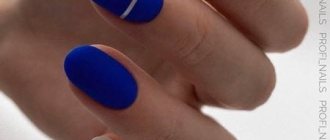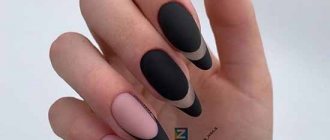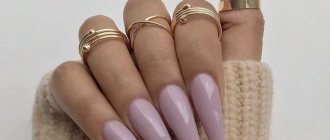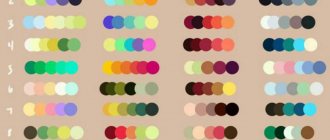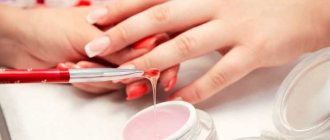Polygel extensions at home
Step-by-step instructions for acrylic gel nail extensions will help you carry out the process at home. To do this, you need to purchase a set for modeling nails with polygel.
Professional equipment includes all necessary materials:
- 4 polygels (clear, white, light pink, camouflage pink),
- construction fluid for leveling acrygel, bonder, dehydrator,
- acid-free primer, classic finish gel,
- sticky layer remover
- brush, spatula, clamps for squeezing polygel out of the tube.
Preparation consists of a thorough manicure, cleansing and dehydration of the nail plates.
Materials used for nail extensions
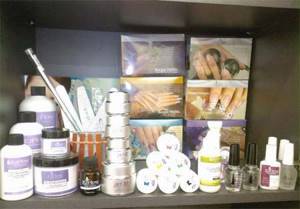
Before starting work, you need to carefully familiarize yourself with the types of materials that will be needed for the work. Mainly you need to pay attention to acrylic, gel and silk. At the same time, you need to know that the use of one or another material depends on what exactly the client wants.[/box]
For the strength of nails, acrylic is used, which remains intact even with fairly serious impacts on the nails.
Gel nails are less durable and can crack if hit. But the gel creates a color as close as possible to the natural color of the nail.
Silk is most often used to repair nails. It is used to cover a cracked nail, applying gel on top.
Nail extensions are carried out in the same way, regardless of the material used for this. The process uses either special forms placed under the nail or plastic tip plates. They are usually glued to the nail, used when there is no free edge of the nail or when the nails are very brittle and thin.
How to extend onto upper forms
The top shapes help you to grow your nails into the perfect shape without much effort. The duration of the procedure is reduced to 40 minutes. Process algorithm:
- Forms are put on the prepared nail plates and a base coat is applied.
- A ball of acrygel is squeezed out of the tube, picked up with a spatula, and applied to the nail. The brush is moistened in a special anti-stick liquid.
- Begin to distribute the polygel from the cuticle, to the side rollers, over the entire surface. You can add material without worrying about noticeable transitions.
- The nail is dried in a diode lamp for 30 seconds.
- The mold is removed and the nail is clamped to create an arch shape.
- It is given the ideal shape using a file (180-240 grit) and a buff.
- Apply top coat or gel polish.
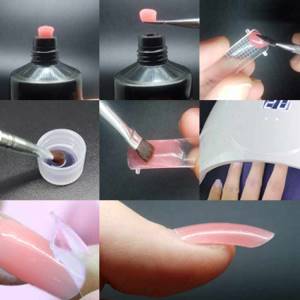
How to grow without forms
The nail is degreased, covered with a layer of primer and allowed to dry for 1 minute. If the nail plate is dry, then you can do without a primer. Step by step process:
- A little acrygel is squeezed out of the tube, a drop is removed using the flat side of a spatula. Apply to the nail.
- The brush is moistened in the construction fluid so that the bristles do not stick to the material. Acrigel is easily pressed onto the first third of the nail plate.
- The nail is formed by distributing the material according to the principle of a gel for extension.
- Dry in a UV lamp for 2 minutes or in an LED lamp for about 30 seconds. Remove the sticky layer, if any.
- The surface is smoothed using a file (180 grit).
- Before applying gel polish, the nail surface is coated with a primer. Then it is dried in a lamp, a layer of topcoat is applied, and dried again.
Nail extension with polygel on tips
How to extend nails onto tips with polygel? For this method, you will additionally need to prepare a set of suitable tips, wire cutters for cutting them, and glue for the tips. The nails are carefully prepared, the tips are laid out in order.
Procedure:
- On each frame, the edge of the contact zone is filed.
- The nail plate is degreased and glue is evenly applied to the contact zone.
- Holding the backing at an angle of 45 degrees, apply from the edge to the middle of the nail plate.
- The frame is pressed for 15 seconds until it fully adheres to the nail.
- After final fixation, adjust the shape of the tips using a tip cutter and file. The file is passed over the entire surface of the substrate to ensure better adhesion to the acrygel.
- An acid primer is applied and dried.
- Then apply an acrygel ball and distribute it evenly over the entire surface, starting from the cuticle. If necessary, add polygel again.
- Further steps for acrylic extensions are similar to the previous options.

Important! Removal of polygel is carried out using a router or using a file (160-200 grit). Independent attempts to tear off the coating or soak your nails in special. liquids will lead to damage to the nail plate, so it is recommended to contact a specialist.
Necessary materials
materials are needed for nail extensions :
- gel;
- tips;
- primer;
- cuticle oil;
- forms;
- degreaser;
- napkins;
- finish.
For high-quality extensions, you should pay special attention to the choice of materials. The gel should not be the cheapest and should not have a strong odor.
Let's take a closer look at the process of choosing materials for beginners and what you should pay attention to when purchasing them.
Gel
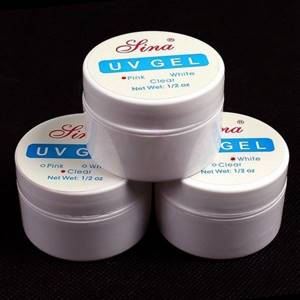
Gel for nail extensions is the main material in the master’s work. It should be chosen with extreme care and attention. Gel happens:
- Single-phase. Standard option for extension material. This gel is considered the most economical and multifunctional. One product is used as a base, anchoring and modeling;
- Two-phase. The gel contains 2 components that: cover;
- protect;
- form the nail plate.
Gel for nail extensions can be transparent and colored, but this does not affect its hardening under UV rays. Its speed depends on the quality of the material and its application scheme.
At home, a single-phase type of gel polish is used.
Tips
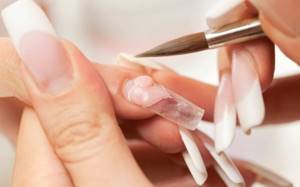
Tips are plastic molds that look like natural nails. When doing nail extensions, they are needed to increase the length of the nail plate. Tips can be of different shapes and lengths, colors and designs, and the material from which they are made differs.
When choosing tips for nail extensions, you should give preference to a type that is close to the shape of the nails. This will allow them to be firmly installed and avoid deformation of the nail plate. Also, when choosing a material, pay attention to the material of manufacture. They should be soft, but not breakable.
To give the tips the desired shape, do not cut them with nail scissors. To carry out this procedure, there is a special tool - a tip cutter.
Tips are divided into sizes - there are 10 in total. Numbering is from 1 (smallest) and above. When using the material, the numbers are removed with a nail file.
Primer

Nail primer is a product used to degrease the nail plate in order to prepare it for the application of gel for a long period. The material protects the nail from exposure to chemically harmful substances.
The primer cannot be dried in a UV lamp.
In the process of gel nail extensions, the primer can be replaced with simple vinegar or alcohol. These two products do an excellent job of degreasing the nail plate and disinfecting it.
Cuticle oil
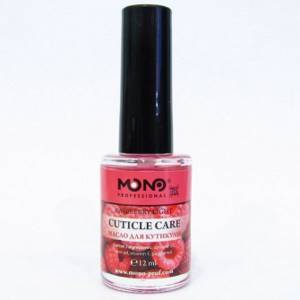
Applying oil to the cuticles is the final step in gel nail extensions. It is used to prolong the effect of trimmed manicure. Thanks to the oil, a woman can forget about the need to trim her cuticles until her next extension correction. And this is approximately 4-5 weeks.
Finish
The main task of the finish is to preserve the gel coating for a long period. When applying a high-quality finish, you can forget about re-extension for 3-4 weeks.
Finish gel comes in two types:
- With a sticky layer. This type of material covers the entire nail to preserve the design for a long time. If you do not cover the design with a finish with a sticky layer, the design will crack and look sloppy;
- No sticky layer. This finish polymerizes quickly and does not require further removal.
Popular finishes include the following brands:
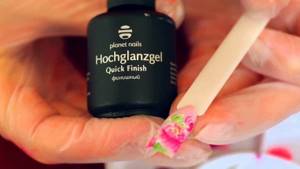
Finish gel Planet nails
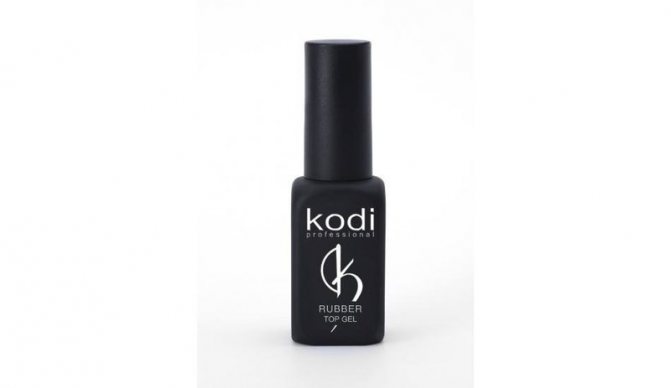
Finish gel Kodi
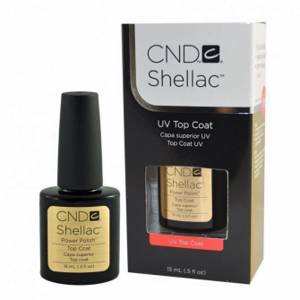
Finish gel for CND extensions
Peculiarities
The material under discussion is a hybrid of gel and acrylic. Initially, manicurists had to mix them manually, carefully selecting the proportions. But now such a product can be bought ready-made, which makes the work much easier.
When preparing a polygel, a high-quality construction gel is mixed with a minimal amount of acrylic powder. The resulting product has a consistency similar to plasticine.
Main features of the material (in descending order of importance):
- The nail extension process takes place without a pungent aroma (unlike pure acrylic), and after treatment with a lamp the plates become very dense and do not break (unlike the usual gel).
The material does not cause allergies and is suitable even for people suffering from asthma.

- The polygel is easily leveled, and the remaining product is instantly removed and can be used further. As a result, the time spent on the entire extension process is significantly reduced.
- Initially, the material was intended exclusively for working with upper forms. But today it is successfully used to build up the lower ones. Interestingly, the product is laid out almost in the same way as acrylic.
Only it does not harden instantly, but retains its plasticity until processed in a lamp. The main thing is to properly prepare your nails.
- When working with the material correctly, various errors are completely eliminated. For example, detachments and “pockets” filled with air. These problems are common with acrylic.
- In sawdust, the material is harder than gel, but softer than acrylic.
- Polygel does not lag behind the nails in the free edge.
- Without polygel, it was difficult for the craftsmen to work with the upper forms. When regular gel was placed on them and transferred to the lamp, it began to flow out heavily. And then it could form unsightly bumps in the cuticle area that needed to be cut out, which severely injured the delicate skin.
Such problems do not arise with the new product.
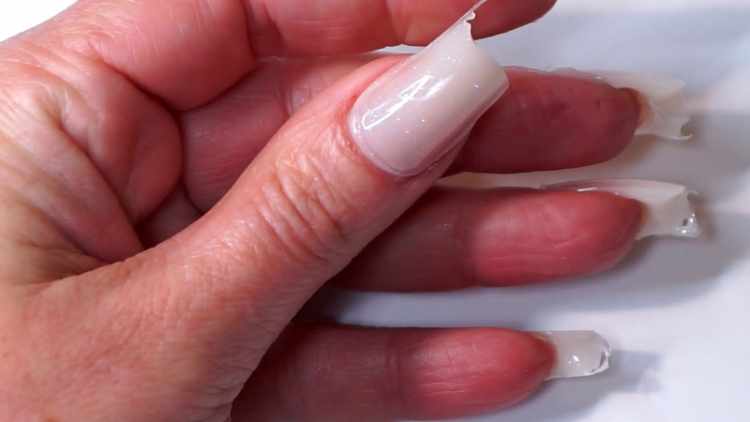
What to do before getting nail extensions
- Get your hands in order. For extended nails, the cuticle is not cut. It is carefully moved with a wooden stick.
- Determine what length of nails is needed for extensions . It is impossible to increase the length of your own nail by more than 3 mm using the gel itself. You can even stick tips on a nail that has been cut at the root, after which they need to be shortened. On the forms, the nail is immediately made to the required size, only then it is lightly filed, but in this design your nail must be at least 2 mm.
- Decide what extension material you will practice with , gel or acrylic. As a rule, craftsmen work with one material all the time.
There is ongoing debate about whether constantly wearing artificially created nails is harmful. There are women who have been carrying out this procedure for more than ten years without a break and are not going to give up a beautiful and vital manicure. The work of a good, proven master will never harm your hands, but it all depends on the condition of your own nails. Whether you need to give your nails a break from extensions is up to you to decide.
Rating of the best funds
A detailed table will help the artist decide on the appropriate polygel for nail extensions. It contains the best modern means.
Grattol
Texture – enamel, dense on 1-2 layers. On sale you can find 5 shade options at once. Among them: beige in different tones, camouflage, peach. There is an option with glitter. Sold in miniature packages of 30 ml. Very economical to use.
After filing the material, it is recommended to sand the coating with buff (soft) to prevent the appearance of unsightly white spots
Bluesky
Texture: enamel. You can select different density levels. Coral and purple shades are also found in a wide color palette. The minimum volume of the tube is 8 ml. But you can also find 60 ml packages on sale. This polygel does not stick to the brush, so it does not require treating the accessory with a special liquid.
This is one of the few such compositions that can be removed with gel polish remover. The composition has a special fine-grained structure that prevents the formation of small bubbles.
Tnl
The thermoplastic product is thick and very easy to work with. Available in 11 different shades. Texture: enamel. Density – translucent. With a sticky layer. Sold in 18 ml tubes. The coating needs to dry for 1 to 2 minutes, depending on the lamp chosen.
To make working with the composition more convenient, you should use a reusable form for extensions.
Patrisa Nail
The texture of the composition is enamel. You can choose the density - translucent or dense composition. Various shades to choose from. There are also camouflage and beige in different tones. This is a high-quality, but expensive product. Sold in tubes ranging from 30 to 60 ml.
Tertio
Texture: enamel. The product is sold in 3 density options - translucent, dense in 3-4 layers, dense in 1-2 layers. Another inexpensive remedy. Sold in tubes of 30 ml. You can purchase different shades: white, camouflage, milky pink. The material is not picky about the bristles of brushes.
It can be used when working with both natural and artificial accessories.

All of the listed compositions differ from each other not only in their basic properties, but also in price. So, both budget and very high-quality options include, for example, Tnl, the cost of a tube is 350-400 rubles. But for a small tube of Patrisa Nail you will have to pay about 1 thousand rubles. Today, if you wish, you can grow your nails even at home.
The easiest and most convenient way is to use polygel for this purpose. This is a new unique product that combines all the positive features of both acrylic and gel.
The main thing is that it does not have an unpleasant odor, and the particles that are cut off are heavy and quickly settle on the table without flying through the air. Step-by-step detailed instructions will help you understand the features of the process.
Advice to the client about nail extensions
add article
For those who decided to get their nails done for the first time, you need to know some things. They will save your time and keep your nails in excellent condition as long as you wear them.
- Try not to grow long nails for the first time. They cannot be removed like false nails, the moment they get in the way and put on again, until the next visit to the master they will be part of your hands. You need to get used to them gradually. After some time, a couple of days or a week, you will no longer separate yourself and your hands with long nails
- Try to be careful in ordinary situations, for example, when opening the door of a refrigerator or car. Skill will be required when typing on a computer keyboard or using a telephone, and fastening buttons or zippers. Over time, this accuracy will be performed automatically, giving a certain character or even charm to your movements.
- When choosing a design or shape, describe in detail your wishes to the master, tell us what kind of work you often have to do with your hands, be sure to listen to his advice after he looks at your hands. He may recommend not the longest nails for the first extension, perhaps not the shape that you would like to get right away, but you will have to make a decision about what nails you will wear yourself
- Acrylic and gel nails can be removed by contacting a specialist; it is not that expensive, but it takes some time, from 30 minutes to an hour. You can do this even if you don’t plan to build them up, but walk around with your nails after removing them
- Never try to remove nails yourself. You can damage the area where the nail is formed, which can lead to very sad consequences. It may take a lot of effort and time to correct the situation. You may even have to wear extended nails for a long time in order to hide the defect.
- If natural nails grow in an irregular shape (flat, concave or very short), by extending artificial nails, you can straighten their shape and achieve the desired length. For many people, nail extensions help them get rid of bad nail habits and transform the appearance of their hands in one day.
- Do not tap the ends of your nails on hard surfaces, do not use your nails to open anything, do not squeeze or try to bend them. Modern materials with appropriate nail care do not have a negative effect. In addition, your fingers and nails are periodically examined by an experienced master, who can always tell you what to do so as not to harm your nails.
- It is not advisable for pregnant women to have artificial nails, or if you are taking hormonal medications or antibiotics.
The most common Rumors and Myths about nail extensions Myth 1. Nail extensions spoil your natural nails.
Reality: The materials used in extensions do not damage nails.
Both acrylic and gel are safe for natural nails. Nails are damaged by inexperienced, unskilled nail technicians by heavily filing the client’s natural nail. The clients themselves save money on removing and tearing off artificial nails from natural nails along with the top layer of the nail plate, disfiguring the cuticle area with files. While wearing artificial nails, natural nails are in a protected sealed state and are not subject to any aggressive external influences. In most cases, with constant wearing of extended nails, even a damaged natural nail acquires the correct direction of growth and shape, stops peeling and can completely acquire an aesthetic appearance. Extensions are also recommended for those who have a lot of stress on their nails. Myth 2. All masters are the same and do the work the same way and there is no difference where and to whom to go to get your nails done.
Reality: Nail extension is a procedure that requires constant improvement and training from the artist.
Diligence, but at first glance the procedure does not seem complicated. Good masters train for years. Pay attention to the availability of advanced training diplomas. Visiting expensive salons does not guarantee the quality of work. In a salon there is also a much greater chance of running into an amateur or a novice master than with a master at home. As a rule, novice masters go to the salon to work. And most importantly, there is no good nail technician who can do nail extensions for 3 kopecks. Myth 3. Is gel better than Acrylic or vice versa?
Reality: I wonder who started the rumor among the masses that gel is better than acrylic and does not damage the nail.
Acrylic and Gel belong to the same group of chemicals. Acrylates. Myth 4: Extended nails require frequent and difficult care.
Reality: Artificial nails require maintenance only once every 2-4 weeks (correction).
On extended nails, even the cheapest varnish lasts an average of 2 weeks. With artificial nails, you are much less likely to have to do a trimmed manicure with steaming. Dirt collects under such nails less often, and you can forget about hangnails altogether. Myth 5. You can’t fiddle around in water for a long time, do laundry, wash dishes or floors, etc.
Reality: All this can be done, many advise wearing gloves, and this will protect not only your nails, but also the skin of your hands from harmful caustic substances, but washing dishes and without gloves it does not cause much harm.
Myth 6. Natural nails do not breathe under acrylic/gel.
Reality: The very concept of “breathing” is no longer true.
Even an ordinary person who knows how to think logically will understand that this is not so. Nails are keratinized tissue that allows moisture, fat, etc. to pass through small pores. Nail nutrition occurs in the matrix, in the area under the cuticle, and through capillaries, so just use cuticle oil, drink vitamins and your nails will receive the necessary nutrition and be healthy ! Myth 7: Artificial nails break quickly.
Reality: In fact, extended nails are very strong and very difficult to break, provided, of course, high-quality materials and a good master.
Exceptions: excessive sweating of the hands, pregnancy, taking hormonal medications (including contraceptives). So if the material begins to peel off, crumble, or does not stick at all, look for a problem in the master or in your health. Myth 8: Extended nails require frequent and difficult care.
Reality: Artificial nails require maintenance only once every 2-4 weeks (correction).
On extended nails, even the cheapest varnish lasts an average of 2 weeks. With artificial nails, you are much less likely to have to do a trimmed manicure with steaming. Dirt collects under such nails less often, and you can forget about hangnails altogether. Myth 9: Extending toenails is nonsense.
Reality: In fact, toenail extensions can solve the problems of many women.
Of course, we mean problem nails. In addition, such a service can be very useful in the summer, when you want to look perfect. Moreover, it is even easier to care for extended toenails, and for those who have good toenails, you can simply seal them with gel, either colored or in the form of a “French manicure.” This coverage will be enough for 5 weeks for sure, or even more. Nail correction, what is it for?
Nail correction is important!
Nail correction is an important procedure that should not be neglected. During it, material is added to the nail area, next to the cuticle, the smile line is raised (if possible), and the beautiful shape of the nail is restored. It is very important to observe certain time intervals between corrections, which should be about 2-3 weeks. This period is explained by a certain growth rate of natural nails. If correction is carried out during the procedure, this will avoid deformation of the material, ensure the stability of artificial nails and require a minimum of time and expense. Thus, when applying nail extensions, it is necessary to carry out corrections regularly. Sealing techniques may be used during the procedure. Correction is necessary due to the fact that after extensions the nail grows, and after a while the hole area ends up without the material used (gel, acrylic), the nail tip becomes longer and, as a result, there is a risk of breaking it off. Nail correction is carried out efficiently, but requires at least 1 hour. There should be no visible discharge of material. In case of detachment, it should not be more than 1 - 1.5 millimeters. Even in this case, you need to think about whether the material used is chosen correctly. In addition, the cause of detachment may be careless handling of nails, the use of active alkaline products in everyday life, a large length of the free edge, exacerbation of various chronic diseases, and the use of antibiotics. Why does nail peeling occur?
You got your nails done...
You are happy that your nails are now like an example of beauty and grace. But very little time passes and you begin to observe that your nails begin to peel off. You get upset and start scolding the master. After all, you place all the blame for detachments on the master. But is the master always to blame here? But according to statistics, quite often extended nails peel off in the very first days. But the master has absolutely nothing to do with it. Other reasons play a role here. Which? Below we provide a list of small rules and tips:
- A few days before the procedure, try to wet your nails as little as possible. The main task is to make the nail plate less saturated with moisture.
- The procedure should be canceled if you feel unwell. After all, if you took hormonal or antibiotics, it is because of these drugs that detachment may begin in the very first days.
- If you are pregnant or already breastfeeding, this procedure is definitely not for you right now. A special hormonal background will be to blame for the detachments.
- If you have high humidity on your hands, warn your technician in advance - this feature can sometimes lead to rapid detachment of nails.
- have you started your period? – it’s better to wait a few days and only then go for the procedure. After all, it is known that these days it is not recommended to paint or extend nails.
You see, there are a number of reasons why nail peeling occurs, and the master has nothing to do with poor-quality work. Most likely, the layers depend primarily on you. After all, if you learn these simple rules, your extended nails will last you longer than usual and will delight not only your eyes, but also the eyes of the people around you.
Kagramanyan Christina
|
18.11.2011
|
Vote:
Tags: nail extensions
- Types and technologies of nail extensions
- Gel modeling on forms
- Let's grow nails correctly!
- Gel modeling on tips
- Memo to the client
Discussions on the forum on the topic:
- Nail extensions
- "Crystal" nails
- Nail extension materials
- Contraindications for nail extensions
- Nail extensions at home
What is polygel
One of the completely new materials on the beauty services market for nail extension and strengthening is polygel. This is a natural acrylic that allows you to create beautiful nails in a glossy or matte finish that will make all your girlfriends delighted and envious.
Acrigel combines the properties of two popular materials: acrylic and gel. High level of density, reliability, durability are just some of its advantages.
Acrylic is used for these purposes as an independent unit for nail extension. Simple gels of various compositions look attractive, but wear off faster and are less reliable.
Polygel is a mixture where acrylic is one of the key components. Working with the mixture is simple; it does not require special skills, preparation or conditions for application and strengthening. Polygel has a number of advantages , among which it is important to note:

- Polygel nail extensions are distinguished by their durable surface. It looks natural, and to make nails beautiful, smaller amounts of substance are required than, for example, acrylic alone,
- The substance does not have an unpleasant odor, no chemical odor, so after working with it you do not have to ventilate and thoroughly wash off any foreign “aroma”,
- Such nail extension products do not harden without special exposure to ultraviolet radiation, so you can take your time and give your nails any shape and appearance you like,
- Klenser is a liquid that simplifies application. It does not allow the polygel to spread over the nails, harden and makes the process of applying the substance uniform,
- The skin around the nails does not suffer, since the high viscosity of the substance does not allow it to get where it is not needed. Polygel in its hardened state is durable, so it is impossible to damage the extended nails with polygel.
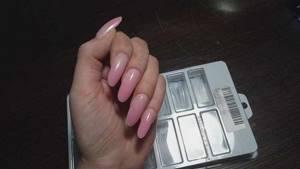
How to apply it correctly?
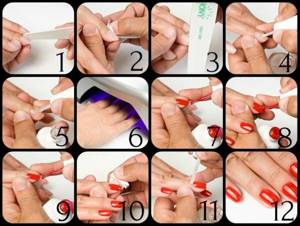
Despite the fact that gel polish is a common product, not everyone knows how to use it correctly. How long the coating will last depends on how correctly and technologically the nail extension is done. When done correctly, it lasts twenty-one days without fading or chipping. If the nail extension technique is broken, then in the first days or hours, chips and cracks may appear. For a greater aesthetic effect, a manicure is performed before extensions.
Nail extension with gel polish is a long process that takes place in several stages.
- First you need to correct the shape of the nail. We align the edge of the nail plate and clean it so that no nail dust remains.
- Peeling nails are filed using a fine abrasive file. Movements should be longitudinal, not transverse. Be sure to use an orange stick or a pusher to get rid of the cuticle. We thoroughly clean the nails and degrease them.
- Now you need to remove the top layer of the nail plate. For this purpose, coarse-grained buffs are used. Only the glossy layer is removed, after which they take on a matte finish. This must be done carefully, without pressing too much. If you remove a lot, the plates become thinner and it is difficult for them to recover.
- Afterwards, we dry the nails with a dehydrator, removing dust, moisture and grease.
- Then, you can apply the first layer of gel polish, but before that it is better to coat it with a primer. This will improve the adhesion between the plate and the coating. If your nails are thin, flaky, or weak, a primer is a must. We cover the entire nail with it, as well as the end part.
- Apply a layer of base gel. It is necessary for the bond between the nail and the gel coating. In addition, the base layer protects the nail plate from the toxic effects of gel polish. It needs to be applied very thinly. Using light movements from the edge of the nail plate to the cuticle. And back. Gently, without touching the cuticle and skin areas.
- Afterwards, the nail must be dried in an ultraviolet lamp for 60 seconds.
- After drying, the base layer becomes sticky. It is leveled over the surface; for this you need to use only a dry brush.
- Gel polish is applied in one layer for a translucent effect or in several thin layers to give the coating brightness and richness. We apply the layers very thinly, otherwise streaks, unevenness, and waves may appear. We dry the layers in a lamp, each separately. Carefully paint the entire surface.
- We finish by applying the finishing layer. The finishing layer fixes the coating and adds shine. The finishing layer should be thicker than the base layer. Cover the nail plate completely with it. Dry for 120 seconds in a lamp. If the finishing layer is not dried well, the coating loses its shine.
- Then you need to remove the dispersion layer. For this, Klinser is used. Cleanser is a special composition used to remove dispersion from gel coatings.
If you follow technology, you can prevent many difficulties associated with this process. It is important to use high-quality materials and tools. Read the description of each product carefully and follow the instructions on the package if you are a beginner. Use products only from trusted brands. Observe drying times. It may vary depending on the brand of the manufacturer. Typically from 120 seconds under UV or 30 seconds under LED.
Additional reinforcement
The process of strengthening nails with polygel is simple and includes the following steps:
- It is necessary to carry out a clean manicure, wipe the nails with a dehydrator,
- Apply the base and dry under the lamp,
- Moisten the brush and spread the acrygel in a thin layer over the surface of the nail. Dry under a UV lamp.
All that remains is to file your nails and give them the desired look.
How to remove polygel
When new nails have turned into old ones and you want to remove them, then there will be no problems with polygel. Nails can be removed easily using a very ordinary 160-200 grit file or a special manicure cutter.
Acrylic extensions: tools and materials
In order to extend nails using acrylic, you may need special forms or tips (if you choose medium length or more). Otherwise, the set of consumables is almost exactly the same as that needed for gel extensions. This:
- Manicure set;
- Orange sticks;
- Files;
- Buffs;
- Brushes;
- Degreaser;
- Ultraviolet lamp;
- And so on as desired.
The difference is that acrylic extensions require a different base: liquid monomer and acrylic powder. Since the monomer has a very strong, unpleasant odor, this manicure should be done in a well-ventilated room.
Monomers with a milder odor do not last as well.
The difference between acrylic varnish and gel polish is that they acquire a solid form under different conditions, and besides, acrylic can withstand even strong temperature changes much better than gel.
To work, you will also need a flat container with small edges and a wide bottom to make it easier to rinse the brush during the process.
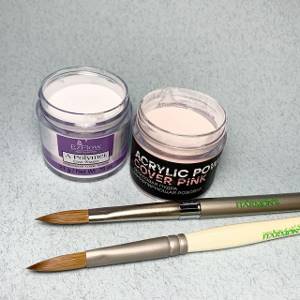
@profmixru
Advice from experienced manicurists
A novice nail extension artist has plenty of opportunities to learn independently using video tutorials or articles on the Internet. It’s better to take real master classes from professionals. They can share their secrets and valuable information.
Here are some of the tips:
- To create a three-dimensional design, polygel can be mixed with gel polish.
- To avoid detachment, when applying the material must be carefully pressed against the cuticle.
- The impermeable film created by gels, varnishes, and acrylics serves as a breeding ground for bacteria and fungi. Therefore, disinfection is necessary when using decorative coatings.
- You need to file your nails after they are completely dry. A wet nail plate is very vulnerable to mechanical stress and may begin to peel off.
- Nails need to be given periodic rest to recover, and not even use nail polish.
All stages of the process, from nail preparation to extension and design, are similar to techniques for working with gels and gel polishes.
If you have the skill of building extensions with these materials, mastering the use of acrygel will not be difficult.
Benefits of the procedure
Nail extension with fabric has a number of advantages, thanks to which it can be used as an independent method of nail extension. The main advantages of the technique include the following points.
- Nails extended using the fabric method are quite impact-resistant and elastic.
- It is very easy to repair a damaged nail - a new layer of tissue is simply attached to the crack.
- The procedure can be carried out using various fabrics - extensions with fiberglass, linen, silk, depending on the client’s wishes.
- Thanks to the presence of a variety of colors and textures of fabrics, you can get different designs on your nails, which allows you to eliminate the need to constantly use a coating.
- Nail extensions using fabric covering are as hypoallergenic as possible and are almost incapable of causing an allergic reaction.
Nail extensions with fabric allow you to extend nails of various shapes and lengths with flax, silk or fiberglass (fabric that looks like silk and is made from fiberglass). The principle of the technique lies in the fact that a tip (plastic nail) is glued onto your own nails, onto which layers of fabric are glued.
Advantages and disadvantages of gel extensions on forms
This type of extension makes it possible to:
- It is enough to lengthen short nails,
- give them the desired shape and elegance,
- improve the appearance and match the natural color,
- to extend wide nail pads, although it is difficult to do this on your own, only professionals can do it,
- quickly carry out the process, unlike, for example, when building up with tips.
The main thing is to get used to it. Disposable paper forms are quite suitable for the job. Although experts advise using Teflon or metal. The main thing is to thoroughly disinfect both materials and nails after each procedure.
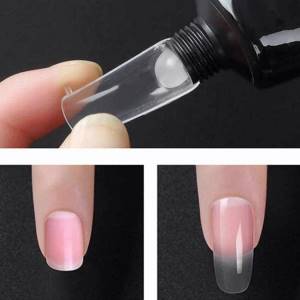
The good thing about this method is that it is non-hazardous, does not cause allergies, and does not violate the integrity and structure of the nail plates. The gel stays on the nails for quite a long time after extensions, acquires a natural shade after drying and is odorless.
Nevertheless, artificial extended nails require careful handling. They can quickly break from an accidental blow and do not withstand mechanical stress.
On the other hand, artificial nails can always be restored; you just need to change the stencil and start the procedure again. The gel will give your nails elasticity and visual similarity in color to natural ones. The main thing is to choose a durable material for adhesion, a beautiful stencil, and skillfully apply the selected design.
Coating your nails with gel and adding nail extensions to forms is a simple procedure, but it will require skill and time to achieve the perfect manicure.
It is important to first prepare the nail plates, select high-quality materials for work, and not be distracted during the process. In the future, protect the nails from mechanical damage and contact with abrasive chemical elements.
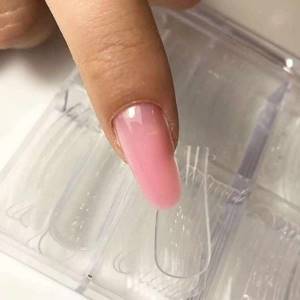
Nail tips - what are they? Is it difficult to extend nails with tips at home?
Tips are special artificial overlays for nails (from the English word “tip” - “tip”). They are needed to give the nail plates the required length and shape. Such tips must be strong and elastic at the same time, because a large load falls on them. They are usually made from polymers and stay on the nail plate for 3-4 weeks.
There are two types of nail extensions: tips and forms. Molds are made from paper, foil or flexible plastic. To create an artificial nail coating in both cases, gel or acrylic is used, which is applied either to tips or to forms. It is better not to use forms at home, since the likelihood that the nails will turn out the same is very small.
“Extensions to tips will guarantee that they will be the same, and the kit always contains glue for applying them. The glued tips are coated with your choice of gel or acrylic,” says Anna Shevchuk.
Nail care at home and in the salon
Healthy nails look great even without an elaborate design. The use of various decorative means for decoration often leads to a deterioration of their condition, so taking care of the nail plates should become a regular habit. Home care is based on several rules:
- High-quality manicure tools are the main condition for healthy nails. For natural nail plates, glass, ceramic, and crystal files are the safest. They need to be filed in one direction.
Care products should include hand cream, cuticle oil, and strengthening product.
- Regular warm oil baths for hands made of olive, almond, castor oils with the addition of lemon juice. Dipping your fingertips into lemon pulp will help whiten your nails.
- Intake of nutrition from food containing vitamins C, D, B, A, E. Food requires a sufficient amount of zinc, iron, iodine, magnesium, calcium, biotin, folic acid.
- Salon nail care procedures: professional manicure, paraffin therapy, sealing, various types of extensions.

Care for extended nails
In order for a beautiful manicure to last 3-4 weeks in its original form, it requires appropriate care:
- Do not wet your hands during the first 24 hours after the procedure. You can wash and shower, but visiting the pool and sauna is not advisable. Liquid and temperature changes make the gel brittle.
- Protect your hands from mechanical damage and excess moisture. Housework should be done with rubber gloves.
- Take care of the skin of your hands and cuticles by rubbing in a nourishing cream daily.
- Overgrown nails can be “revitalized” by covering them with regular colored varnish. This will give them shine.
- Corrections should only be made with a nail file; cutting the gel plates with scissors is strictly forbidden, as this will permanently damage their shape.
- To perform a hygienic manicure on artificial nails, you should not steam. Softening the cuticle can be done using oil.
- If the extensions were carried out using acrylic, then under no circumstances should you use nail polish remover. This substance contains acetone, which causes yellowing and brittleness of the plate.
No matter how beautiful your extended nails look, you still need to take a break from this procedure from time to time. After extensions, they look lifeless and dry. After all, in the process the protective layer of the plate is removed, and the access to oxygen is blocked for a long time. The health of natural nails must be monitored, otherwise the patients will have to take a very long time to restore.
Nail preparation
Before the extension procedure, you need:
- Get your nails in order, trim off excess length and polish.
- Choose the right place for the procedure so that there is sufficient lighting.
- Wash your hands with soap.
- Treat the cuticles with antiseptics to prevent the gel from peeling off after hardening.
- Remove all small particles of skin from under the nail plates.
- Sand the free edges for gel extensions.
- Process with a nail file, starting from the edges closer to the center.
- Remove shine from nail plates.
- Clean your nails with a brush and sharpen them with a hard nail file.
- Degrease.
Next, you can begin to attach the stencil, apply a base layer of gel with a brush, lower it into an ultraviolet lamp to harden, and then file the nail to give the desired shape and length.
All that remains is to apply a layer of gel and the desired pattern with paints, varnishes, or you can use ready-made stickers as a stencil.

It is important to make sure that there are no contraindications for the gel procedure or allergies to gel materials.
It is not recommended to take antibiotics or other hormonal drugs the day before that can reduce the quality of work or the desired effect.
We must not forget that household chemicals are used, so it is necessary to carry out the extension procedure while wearing protective gloves.
In the future, it is necessary to carry out corrections every 2-4 weeks so that the nails always look neat and beautiful.
Preparation consists of:
- treating hands with antiseptics,
- removing the varnish coating, old gel layer,
- cleansing the surface of the nail so that air bubbles do not form under the new layer due to polymerization from exposure to an ultraviolet lamp,
- applying a fresh layer of gel,
- sawing off unnecessary parts of the stencil to give the desired shape to the nail.
Preparation of the workplace
Before applying nail extensions, a novice master must properly prepare his workplace. Some tips for organizing it:
- The room should be spacious and bright.
- The work table should be located in the corner. This will provide natural light.
- The desktop should not be very wide. The client and the master should feel comfortable sitting opposite each other.
- If the master prefers to have everything on the table, then it is advisable to choose more of it.
- The table must be stable and have a surface that is resistant to extension products.
- During the procedure, a lot of dust spreads and therefore it is recommended to choose a table with a special hood.
- Armchairs and chairs with adjustable height are selected.
- To create the right lighting, a table lamp with a mount is used.
For convenience, a novice craftsman can use a cabinet for tools and storage of nail files, as well as other auxiliary materials. The master’s workplace should be furnished comfortably and stylishly. Nothing should get in the way, everything should be at hand.
Share with your friends!
Subscribe to our Yandex.Zen channel or Yandex.Messenger
Basic terms
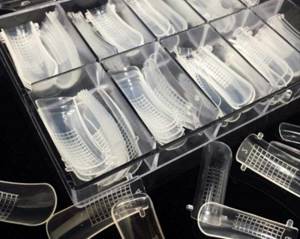
Top forms are a soft plastic product that imitates a natural nail plate and helps create an artificial nail of the desired length and curve. Unlike conventional blanks, they are installed on the nail, and not under it.
The product is odorless and has increased density, which makes it an excellent material for modeling artificial nails. Available in tubes or jars with a lid.
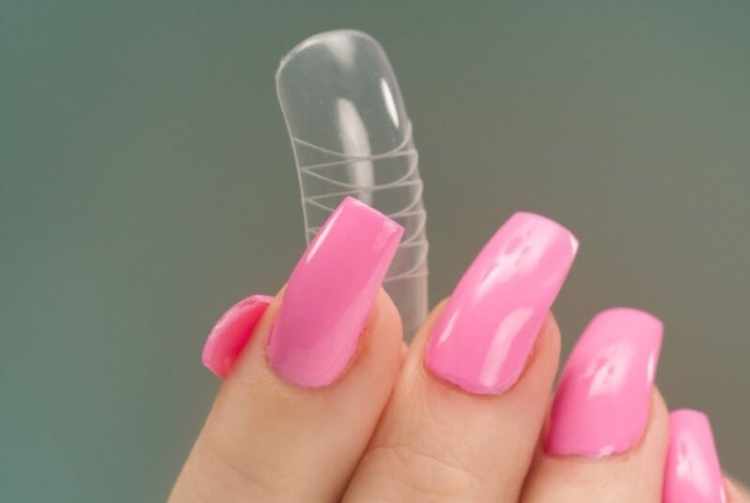
Depending on the bend, there are 3 types of upper forms:
- Natural. Light bend, close to natural,
- Classical. More convex in the center of the structure,
- Standard. The most convex. The result is a nail with a slightly drooping tip.
The specific type is selected based on the data of the natural nail - the bending of the transverse and longitudinal arch is assessed, as well as the desired shape of the extension.
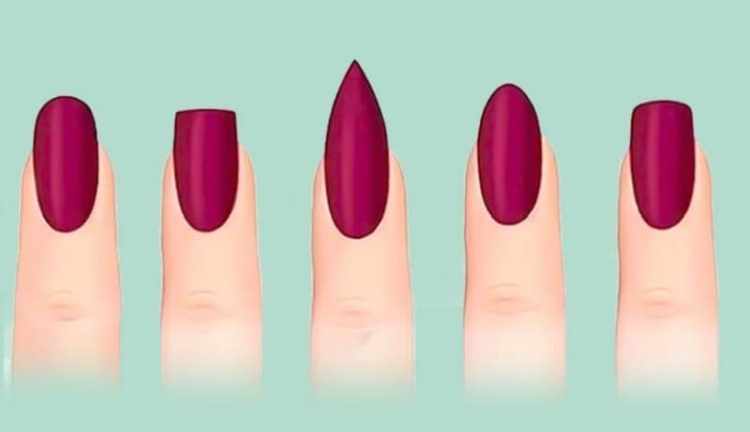
- A natural curve is used for the end result of a crisp or rounded square,
- For the future nail shape "Almond" - standard,
- For an oval – classic.
But this relationship is conditional - you can use any bend, but in some cases this may increase the operating time.
A few important points:
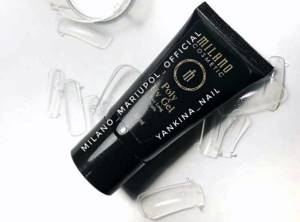
- The upper forms have their own size range, which is determined by the numbers embossed on the plastic. The larger the number, the smaller its size. Depending on the manufacturer, the largest figure may vary. Common numbering of sizes is from 1 to 10,
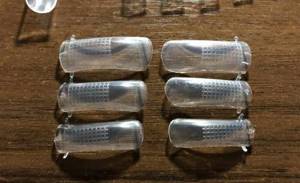
- Depending on the manufacturer, it can be with or without printed lines. The marks on the plastic are intended to determine the length of the future nail and carefully lay out the material. Forms with markings are offered by dozens of manufacturers, for example, PNB, Formula Profi, Monami, Vogue Nails,
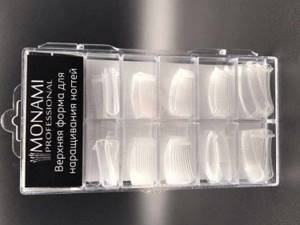
- There are small handles at the ends of the plastic blanks - they help separate the plastic without damaging the artificial nail. Find forms with handles from the brands Monami, Vogue Nails,

- On the upper forms, extensions are done with any type of gel. But most often it is polygel that is used, since it has a dense texture and does not “roll off” from the sides. When choosing a product, pay attention to the brands Canni, Vogue Nails or Patrisa Nail.
Types of forms used in nail extensions
Templates differ from each other in the following parameters:
- modeling method;
- material of manufacture;
- nail shape.

Reusable Silicone Nail Molds
Their features:
- During extension, the upper forms are applied to the nail, and the lower ones are attached under it. Visually, the top templates are similar to tips, but the method of modeling on the tips is different.
- Disposable forms are intended for one procedure, but they have the advantage that the soft material of the form allows you to easily adjust the templates to the smile line on non-standard shaped nails. Reusable ones are tougher and are intended for repeated use.
- The materials used to make molds can be hard or thin plastic, metal, paper, or foil.
- The templates also differ in the type of nail tip and can be oval, round, square, almond-shaped, as well as stiletto, edge or pipe.
The most popular options today are the classic almond-shaped and extravagant age.
For permanent, especially professional use, as well as reusable use, you should choose high-quality materials from well-known brands.
The difference between the upper forms and the usual ones
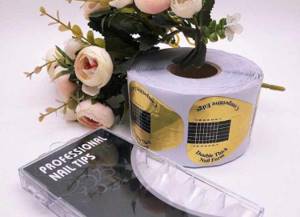
The usual forms mean tips, liquid tips and disposable templates for extensions.
- The upper ones are reusable. After polymerization, the material separates effortlessly and leaves no marks on the workpiece, so it can be used until it loses its bending. Approximate service life – 2 years,
- The top forms do not polymerize along with the coating, but are removed immediately after the material has hardened,
- The technique of working with forms allows you to save material and create nails that are close in thickness to natural ones,
- The extension procedure is halved and ranges from 1 to 1.5 hours including decoration,
- The end result requires almost no modification. After polymerization, you only need to remove excess and polish the resulting nail,
- Unlike liquid tips, where the material is applied only to 2/3 of the natural nail, top forms involve laying gel over the entire nail plate,
- There is no need to add material after removal.
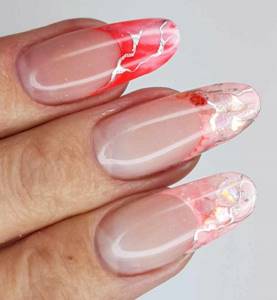
How to choose a template
Choosing the right template for extensions is the key to a beautiful, sophisticated manicure. Focus on the manufacturer, the material used to make the blanks and, of course, the shape of your own marigolds. The recommendations below will help you avoid making the most common mistakes:
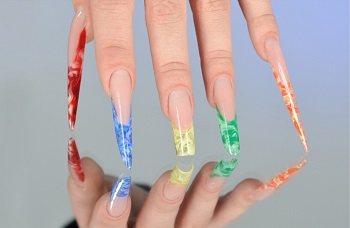
Extended nails of different shapes
- Oval and almond are the ideal choice for full, short fingers.
- Rectangular and square are suitable for those with long, thin fingers and beautiful nail plates; on other fingers, this shape will visually shorten the nails.
- Pipe and stiletto are done on long nails, and edge is suitable for both long and medium-length nails.
A correctly selected template shape guarantees the most accurate modeling result and, as a result, a flawless manicure.
Watch the video for a review of disposable paper forms for extensions and professional tips on their use:
How to grow gel nails using tips yourself
Since gel nails are a different technology, different from acrylic, therefore, different materials and equipment will be needed.
Required gel coating kit:
- Ultraviolet lamp;
- Gel brush;
- Gel (here it should be taken into account that there are different gel systems: single-phase, two-phase and three-phase. For training, it is better to buy a single-phase gel);
- Primer for gel;
- Tips;
- Glue;
- File 120x180 grit;
- Buff;
- Final protective coating.

Gel nails at home - step-by-step instructions:
- Treat the nail plates with the soft side of the file to remove their natural shine;
- Select tips of the required size and glue them to your legs;
- File down all the tips, removing the fade from them and giving them the desired shape;
- Apply a thin layer of gel primer to one hand first, dry it in the lamp for 2 minutes. Then do the same on the second hand;
- Start applying the gel to your little finger. Dry each finger in the lamp for at least 2 minutes;
- When the gel has been applied to all nails, file down all the irregularities, lengths and sides;
- Treat your nails with a polishing buff;
- Dust off your nails and coat them with finishing gel.
For more detailed instructions on how to learn how to extend nails with gel on tips and what the required set of materials looks like, watch the video tutorial:
https://www.youtube.com/watch?v=r52FPK0FWWE
Types of materials and extension technologies
To do nail extensions at home, you need to know what materials are available. In addition, there are various nail modeling technologies. Everything should be sorted out in order.
Acrylic
Acrylic is a thermoplastic, environmentally friendly and wear-resistant polymer that hardens when exposed to air. It lends itself well to modeling, and by changing the reagents, you can modify the external properties of the material: hardening rate, transparency, density. Just 20 years ago, acrylic was used in dentistry, and dental fillings were made from it. This only confirms the high characteristics of the material. Today it is widely used in the nail industry. For beginning craftsmen, acrylic is an easier medium to work with.
Gel
Gel is also a polymer, but it is highly photosensitivity. Under the influence of UV rays, the structure of the material hardens, turning from a jelly-like medium into a solid one. Working with gel requires more experience and dexterity than with acrylic. Also, the gel coating is more fragile, it does not need to be filed as intensively as acrylic, otherwise it is easy to ruin the shape of the nail.


